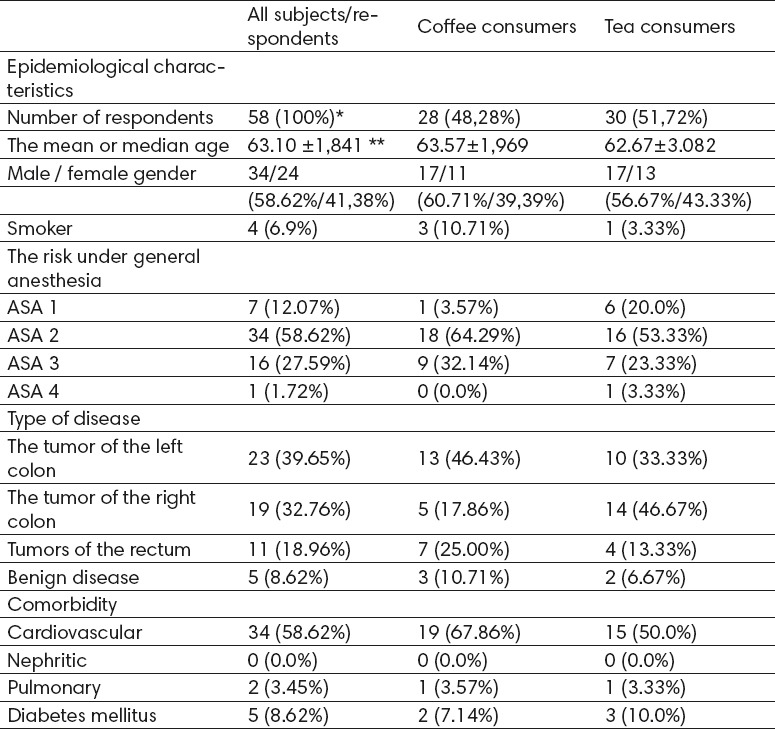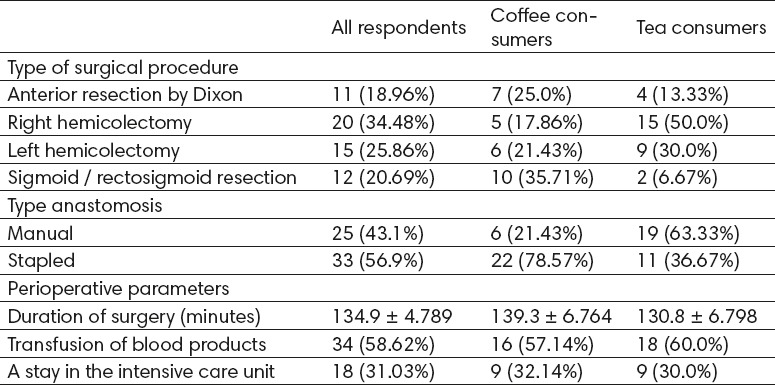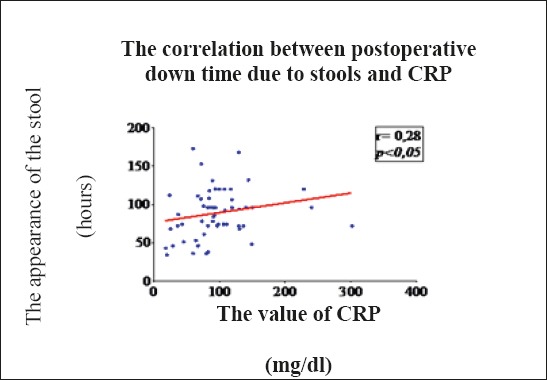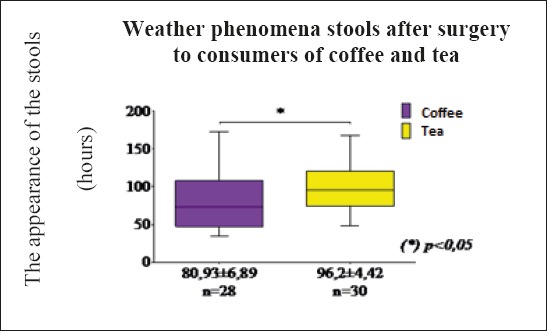Abstract
Aim:
Resection surgery on the colon and rectum are changing both anatomical and physiological relations within the abdominal cavity. Delayed functions of the gastrointestinal tract, flatulence, failure of peristalsis, prolonged spasms and pain, limited postoperative recovery of these patients increase the overall cost of treatment. Early consumption of coffee instead of tea should lead to faster restoration of normal function of the colon without unwanted negative repercussions.
Method:
This study is designed as a prospective-retrospective clinical study and was carried out at the Surgery Center Tuzla, during the year 2013/ 2014. Sixty patients were randomized in relation to the type of resection surgery, etiology of disease-malignant benign, and in relation to whether they were coffee users or not. Patients were divided into two groups. The first group of thirty patients was given 100 ml of instant coffee divided into three portions right after removing the nasogastric tube, first postoperative day, while the second group of thirty patients got 100 ml of tea. Monitored parameter was: time of first stool and the second group of monitored parameters was: whether there was returning of nasogastric tube or not, increased use of laxatives, whether there was anastomotic leak, radiologic and clinical dehiscence, audit procedures, or lethal outcomes in the treatment of patients.
Results:
A total of 61 patients were randomized into two groups of 30 int he group of tea and coffee 29 in the group, two patients were excluded from the study because they did not consume coffee before surgery. Time of getting stool in the postoperative period after elective resection surgery on the colon and rectum is significantly shorter after drinking coffee for about 15h (p <0.01). Also, the length of hospital stay was significantly shorter after drinking coffee (p <0.01). Time of hospitalization in subjects/respondents coffee consumers on average lasted 8.6 days with consumers of tea for 16 days. The incidence of postoperative complications was significantly lower after consumption of coffee (p <0.05).
Conclusion:
Postoperative consumption of coffee is a safe and effective way to accelerate the establishment of the bowel function after colorectal resection surgery.
Keywords: coffee, recovery functions colon and rectal resection surgery
1. INTRODUCTION
Deferred function of the gastrointestinal system is a condition characterized by transient interruption of adequate bowel function after surgical intervention. This results in a disturbed and coordinated peristaltic which is leading to the accumulation of intraluminal gas and liquid mainly in the small intestine. Clinically, this condition is manifested by abdominal distension, nausea, vomiting and food tolerance (1).
Deferred function of the gastrointestinal tract is an inevitable event after major abdominal surgery and is considered the main cause of the prolonged hospitalization (1). Many authors believe that the belated recovery of the functions of the gastrointestinal tract is a normal phase of recovery after any abdominal procedures, and recovery that lasts longer than five days is considered abnormal (2). Despite numerous technological advances in the surgical treatment and perioperative care, delayed function of the gastrointestinal system after colorectal resection surgery is one of the most common side effects in abdominal surgery. Due to the above, the hospitalization is extended, medical expenditures and patient’s discomfort are increasing (3, 4). An appropriate strategy for addressing deferred functions of the gastrointestinal system includes optimizing anesthesia, meticulous surgical technique, selection of appropriate analgesia, avoiding routine use of nasogastric (NG) tube, early mobilization, early introduction of products in the mouth and use of prokinetic agents (1). These measures are incorporated into the “fast track protocol” which is a combination of measures, based on scientific evidence, that allow better optimization of the operation and post-operative recovery (5).
More recently, many authors suggest the use of various substrates in the early postoperative period, in order to early activate gastrointestinal function, such as the consumption of coffee, chewing gum, and various pharmacological preparations (6-13). The objective of our study was to determine: whether coffee consumption in patients with colon and rectal resection leads to early establishment of peristalsis of the gastrointestinal system.
2. METHOD
This study is designed as a prospective-retrospective clinical study and was conducted at the Surgery Center Tuzla during the year 2013/2014. The study included all patients with resecting surgery on colon and rectum.
The sample size was 61 patients older than 18 years who have had an open laparotomy with colorectal resection procedure for benign or malignant disease of the colon. All medical records used in the study are the Department Round-rectal Surgery Center Tuzla, which refers to the operated patients with elective colon resection during the year 2013/2014. Data was taken from the operative reports where the type of disease was analyzed, type of surgery and the length of surgery. According to the temperature chart, the postoperative course of the patient was followed: the extraction of a nasogastric tube, the appearance of the first stool, local early medical findings, the use of laxatives, restore nasogastric tube and the appearance of complications, abdominal reoperation and death. All patients received antibiotic prophylaxis 1 hour before surgery and 2 grams of cefazolin (cephalosporine) and 500gr metronidazole I.V. According to the scheme, low molecular weight heparin was administered 12 hours before surgery subcutaneously. Postoperatively, the patients were treated on the first postoperative day continuous analgesia (100 g and 2.5 g of tramadol metamizolein the 500 ml of saline solution 6-8 drops/min. for 24 hours).
Postoperative feeding is standardized. The nasogastric tube is removed on the second postoperative day when administered in coffee or tea in the control group, on the third postoperative day liquid diet, on the fourth postoperative day fluent pulpy food. Postoperative patient mobilization was standard for both groups of patients. The patients in the coffee group took three times a day per 100 ml instant coffee NES in 09:00, 13:00; and 18:00 h) by the removal of nasogastric tube. The coffee was served at a temperature of 50-60 C for 10 minutes under the supervision of a nurse. No supplements (milk, sugar) were allowed. Coffee was prepared using a small spoon of NES coffee and 100 ml of boiled water was added.
Patients were divided in two groups, the first group consisted of 30 patients who, after removing the nasogastric tube were provided with three portions per os 100 ml of tea and another group of 30 patients were given three portions of 100 ml of an instant (NES) coffee.
All patients were served drinks between 50-60 degrees and they were consumed over a period of ten minutes. They then followed the two groups of parameters. The first set of parameters are: the time of occurrence of the first stool. Another group of monitored parameters: whether nasogastric tube (NG tube) was returned or not, whether there was an increased use of laxatives, whether there was present or not the appearance of a leak at the anastomosis radiological and clinical dehiscence, whether or not there were any auditing procedures and whether there were any lethal outcomes in the treatment of patients. The distribution value is determined by D’Agostino test, Pearson omnibus test and Kolmogorov-Smirnov normality test. ANOVA test was used to calculate the relative difference distribution variance between variables.
3. RESULTS
We evaluated a total of 60 patients, two patients were excluded from the study because they refused to consume coffee, medium age of standard deviation amounted to 63 ± 2, the youngest participant was 31 years old, and the oldest participant was 82 years old. There was a total of 34 men (58, 62%), and 24 women (41.38%). Epidemiological characteristics are presented in Table 1. Experimental groups were fairly balanced: the frequency of ASA recently, the consumption of tobacco, frequency of comorbidity was equally represented. The tumor of the right colon was significantly more frequent in subjects consumers of tea (p <0.05) with the presence of 46, 67% compared to subjects or respondents who were coffee consumers 17.86%. Right hemicolectomy was significantly higher in the tea with the presence of 15 respondents (50%) than in the coffee group 5 (34.48%) and sigmoid / rectosigmoid resection significantly less frequent (p <0.01) with the presence of 2 patients (6.6%) in the group of tea compared to coffee group with representation in 10 respondents (35.71%). Stapler anastomosis was significantly more frequent in coffee consumers (p <0.01) with the presence of 22 respondents (78.57%) compared to the group of tea with representation in 11 respondents (36.67%). Duration of operation, giving transfusion preparations, stay in the Intensive Care Unit at p <0.05 was equally common in both groups (Table 2).
Table 1.
Distribution of patients in relation to the epidemiological characteristics of the sample, the type of disease and comorbidity. * The value is expressed as an absolute number and as a percentage of the corresponding group. ** The arithmetic mean value ± standard deviation.

Table 2.
Distribution of patients according to the type of surgical procedure, anastomosis and perioperative results.

All patients controlled value of C-reactive protein on the third postoperative day. Coffee drinkers had significantly lower post-operative value of C-reactive protein 64.49 ± 5.2 compared to tea consumers 115.4 ± 9 (p <0.01). In all patients (consumers of coffee and tea), there was a significant positive correlation between postoperative time reporting stool and the value of CRP. In other words, if the post-operative stool occurred later than the values of CRP were higher (p <0.05) (Figure 1).
Figure 1.

Overview of correlation postoperative downtime due to stool sand CRP.
The frequency of a nasogastric tube use, the use of laxatives, abdominal reoperation and death had even distribution of coffee and tea consumers (p> 0.05). Coffee drinkers had a significantly shorter hospital stay 8.6 ± 0.5 compared to tea drinkers 16.1 ± 1 (p <0.01). Postoperative complications (infection of post-operative wounds, abscesses, partial dehiscence of the surgical wound) were significantly less frequent in the coffee group to the proportion 14.29%, compared to a tea group where the percentage of postoperative complications was 36.67% (p <0.05) (Table 3).
Table 3.
Display of laboratory and clinical parameters, and postoperative complications

After the surgery, coffee consumers had their stool significantly sooner compared to tea consumers (p <0.05). The coffee group had a stool after 80.93 ± 6.89, while the tea group had a stool after 96.20 ± 4.417 (Figure 2). They then analyzed the parameters for which the statistically significant difference between the coffee and tea consumers: the concentration of CRP, having stool after surgery, length of hospitalization and the incidence of postoperative complications. These parameters were compared between subjects with stapler and a manual anastomosis, and then with the group of right colon patients and other diseases. Therefore, the parameters between the coffee and tea groups were observed. The concentration of CRP was significantly lower in stapler anastomosis (81.28 ± 7.54 in the tea group, 115.4 ± 10.84 in the tea group p <0.01). Hospitalization was significantly shorter in stapler anastomosis in the coffee group 10.55 ± 0.74 in the tea group 15.12 ± 1.38, p <0.01). The concentration of CRP was significantly lower in tumors of the right colon than in other illnesses: a group of right colon 116.4 ± 13.18, other diseases group 85.27 ± 6.98 (p <0.01). Duration of hospital stay was significantly longer in the right colon tumor patients than in other illnesses: a right colon group 14.95 ± 1.47, 11.24 ± other diseases 0.86 (p <0.05). Then, the parameters which were analyzed were the ones where the statistically significant difference between the coffee and tea consumers was observed, as well as those suffering from colorectal cancer: CRP concentrations and the length of hospitalization. In patients with right colon cancer, the concentration of CRP was significantly lower in the coffee consumers 69.94 ± 9.09, as compared to the tea group 118.9 ± 10.11 (p <0.01). In patients with right colon cancer, duration of hospitalization was significantly shorter in the coffee consumers 8.4 ± 0.87, compared to the tea group 17.13 ± 1.57 (p <0.01).
Figure 2.

Display of stoolappearance after surgery to consumers of coffee and tea.
4. DISCUSSION
The study has showed that the time of establishment of peristalsis in the postoperative period after elective resection procedures on colon and rectum is significantly shorter after drinking coffee. After drinking coffee, the time of the first stool was shorter for about 15 h (p <0.01). Apart from two patients who refused to drink coffee because they did not consume it before the operation it self, the coffee consumption has been well accepted by the patient, and no complications were observed in relation to the consumption of coffee. Also, the length of hospital stay was significantly shorter after drinking coffee (p <0.01). And even after stratification by type of surgery, the respondents who were coffee drinkers had a significantly shorter hospital stay than those who were tea consumers. The time of hospitalization in subjects who were coffee consumers took an average of 8.6 days while for tea consumers it took 16 days.
In the United States, it is calculated that 350 000 colorectal resections and resections of the small intestine done within a year, where the length of hospitalization is eleven days average, will cost the health care system more than 20 billion US dollars, and shorter hospital stays, even if it is only 1-2 days per individual case, may represent a significant financial savings (4). Basic cost of treatment in our hospital for a day amount to 130.74 KM, if you take into account that the lowest average salary in the FBiH is 526 KM, it is clear that shorter hospitalization will definitely make a significant savings.
Together with clinical signs and other inflammatory markers, CRP serves as an indicator of adverse postoperative course, including surgical and non surgical complications. Recently, this protein has been identified as an early indicator of septic complications after resection of the esophagus, pancreas and rectum (8). Interest in CRP in monitoring infection has increased since it was announced that CRP above 140 mg / L, as determined in the third or fourth postoperative day is a good indicator for complications in colorectal surgery (9). Besides shorter hospital stays, faster establishment of peristalsis, and economic benefits, the study showed that coffee drinkers had significantly lower postoperative value of C-reactive protein in relation to tea consumers(p <0.01) while the value of C-reactive protein levels greater than 140 mg / l represent the cut-off value. And after stratification by type of surgery, coffee drinkers had significantly lower levels of CRP in each procedure. In all patients (consumers of coffee and tea), there was a significant positive correlation between postoperative time reporting stools and the value of CRP; In other words, if the operative stool later occurred, the more the values of CRP were higher (p <0.05).
Coffee and tea group in the study are quite balanced, because there was no difference in the consumers of coffee and tea in anything (age, sex, comorbidity, smoking, duration of surgery, ASA score, frequency of administration, transfusion, incidence stay in JINJ). The tumor of the right colon was significantly more frequent in subjects who were tea consumers (p <0.05). Besides him, one more observed difference was at the level of “stapler-manuel” anastomosis, stapler anastomosis is common in coffee group (p <0.01). Therefore, the study analyzed: CRP, reporting stools, length of hospitalization and the incidence of postoperative complications in stapler and the manual anastomosis, as well as colon cancer and other diseases, which were intended to prove that the coffee itself reduces CRP, hospitalization, or it may stapler or a tumor of the colon “problematic” in itself. The concentration of CRP was significantly lower (p <0.01), and hospitalization was significantly shortest in stapler anastomosis (p <0.01). Also, the concentration of CRP was significantly lower and the duration of hospitalization was significantly longer in the right colon tumors than in other illnesses. This means that stapler anastomosis safer, and right colon tumor more problematic than other diseases. Then, CRP and hospitalization in the right colon with coffee consumers were compared. As a result, we found that in patients with tumors of the right colon, concentration of CRP was significantly lower, and length of hospital stay was significantly shorter in the coffee consumers. Here by, we have shown that coffee has effect even in tumors of the colon.
One of the possible measures in resolving deferred functions of the gastrointestinal tract after colorectal resection involves administration of drugs such as alvimopan who µ-opioid receptor agonists. Multicenter, double-blind, placebo-controlled study evaluated the impact the alvimopan had in 654 patients after resection of the small and large intestine. Alvimopan group had the first stool in a shorter period of time, the first gas and first peristalsis. Also, the time of hospitalization for one day was less than placebo group (10). One dose of alvimopan a is $ 62.50 (or 114.32 KM) and $ 937.50 (or 1728.65 KM) for 15 doses of the maximum permissible doses (11). On the other hand, the cost of one cup of NES classic coffee, which was used in the study, is 0.12 KM (or 0.5 KM for a total of four doses were used for each patient) so that the consumption of coffee is a far more economical process with similar effect as a result.
Results of the study published by Muller & Associates in 2012 in the British Journal Surgical and who also examined the impact of coffee on the establishment of peristalsis after elective resection surgery of the colon is comparable with our research (12). Li and Associates published in 2013 cumulative target of study in Gastroenterology, which included systematic analysis of seventeen randomized trials and 1,374 patients in abdominal operating procedure in the postoperative period given chewing gum. Results of the study are comparable to our research. If we consider that cancer of the colon and rectum often affects older population in which the consumption of coffee is an everyday part of the life style we conclude that coffee consumption in relation to the consumption of chewing gum is an adequate measure with similar effect (13). Rao and Associates performed ambulatory colon manometry through a catheter that is positioned to the middle of the transverse colon in 12 healthy subjects. The subjects received 240 ml of coffee, water or decaffeinate coffee or a meal of 1000 kcal, then examined the effect of each stimulus on the motor activity of the colon. The results showed that coffee stimulates the motor activity of the colon as well as meal of 1000 kcal, 60% stronger than water and 23% greater than decaf coffee (14). The effect is compared to the influence of the meal, which is 1000 kcal. Since coffee does not contain any calories, and its impact cannot be explained by volume, acidity and osmolarity, it is only probably the idea of pharmacological effect that we see or get (15).
The study had several flaws. A small sample that would in future researches sought to enhance the performance of multi-center study among several institutions. The heterogeneity of the sample, also, was the limiting factor, which is trying to reduce the randomization and stratification of the sample.
5. CONCLUSION
Our clinical study has demonstrated that postoperative consumption of coffee cheap and safe way to activate bowel motility after colorectal resection. The time for establishing the first bowel movement and stool after resection of the colon and rectum was significantly shorter in the group of patients who consumed coffee compared to the group that consumed the tea which took less time, and was shorter by 15 hours. Coffee consumption in patients with resection of the colon and rectum reduces total hospital stay, and total hospital costs. Faster establishment of normal function of the GI tract is not produced negative repercussions. On the contrary, the overall morbidity in the group that consumed coffee is lower than in the group that consumed tea.
Footnotes
CONFLICT OF INTEREST: NONE DECLARED.
REFERENCES
- 1.Lubawski J, Saclarides T. Postoperative ileus: strategies for reduction. Ther Clin Risk Manag. 2008;4(5):913–917. doi: 10.2147/tcrm.s2390. [DOI] [PMC free article] [PubMed] [Google Scholar]
- 2.Delaney C, Kehlet H, Senagore A, et al. Postoperative ileus: profiles, risk factors, and definitions - a framework for optimizing surgical outcomes in patients undergoing major abdominal colorectal surgery. Clinical consensus update in general surgery. 2006;121:20–26. [Google Scholar]
- 3.Schuster R, Grewal N, Greaney GC, et al. Gum chewing reduces ileus after elective open sigmoid colectomy. Arch Surg. 2006;141:174–176. doi: 10.1001/archsurg.141.2.174. [DOI] [PubMed] [Google Scholar]
- 4.Healthcare Costs and Utilization Project National Statistics [online] 2005. [Accessed February 3 2008]. URL: http://hcupnet.ahrq.gov/
- 5.Wilmore DW, Sawyer F, Kehlet H. Menagement of patients in fast track surgery. BMJ. 2001:322. doi: 10.1136/bmj.322.7284.473. [DOI] [PMC free article] [PubMed] [Google Scholar]
- 6.Mattei P, Rombeau JL. Review of the pathophysiology and management of postoperative ileus. World J Surg. 2006;30(8):1382–1391. doi: 10.1007/s00268-005-0613-9. [DOI] [PubMed] [Google Scholar]
- 7.Ortega-Deballon P, Radais F, Facy O, d’Athis P, Masson D, Charles PE, et al. C-reactive protein is an early predictor of septic complications after elective colorectal surgery. World J Surg. 2010;34:808–814. doi: 10.1007/s00268-009-0367-x. [DOI] [PMC free article] [PubMed] [Google Scholar]
- 8.Ruiz-Tovar Jaime, Morales-Castiñeiras, Vicente, Lobo-Martínez Eduardo. Complicaciones posoperatorias de la cirugía colónica Cirugía y. Cirujanos. 2010;78(3):283–291. [PubMed] [Google Scholar]
- 9.Welsch T, Müller SA, Ulrich A, Kischlat A, Hinz U, Kienle P, et al. C-Reactive protein as early predictor for infectious postoperative complications in rectal surgery. Int J Colorectal Dis. 2007;22:1499–1507. doi: 10.1007/s00384-007-0354-3. [DOI] [PubMed] [Google Scholar]
- 10.Ludwig K, Enker WE, Delaney CP, et al. Gastrointestinal tract recovery in patients undergoing bowel resection: results of a randomized trial of alvimopan and placebo with a standardized accelerated postoperative care pathway. Arch Surg. 2008;143:1098–1105. doi: 10.1001/archsurg.143.11.1098. [DOI] [PubMed] [Google Scholar]
- 11.Heather R, Bream-Rouwenhorst Matthew A. Cantrell. Am J Health Syst Pharm. 2009;66(14):1267–1277. doi: 10.2146/ajhp080445. [DOI] [PubMed] [Google Scholar]
- 12.Müller SA, Rahbari NN, Schneider F, Warschkow R, Simon T, von Frankenberg M, Bork U, Weitz J, Schmied BM, Büchler M. Randomized clinical trial on the effect of coffee on postoperative ileus following elective colectomy. Br J Surg. 2012;99:1530–1538. doi: 10.1002/bjs.8885. [DOI] [PubMed] [Google Scholar]
- 13.Li S, Liu Y, Peng Q, Xie L, Wang J, Qin X. Chewing gum reduces postoperative ileus following abdominal surgery: a meta-analysis of 17 randomized controlled trials. J Gastroenterol Hepatol. 2013;28:1122–1132. doi: 10.1111/jgh.12206. [DOI] [PubMed] [Google Scholar]
- 14.Rao SS, Welcher K, Zimmermn B, Stumbo Is coffee a colonic stimulant? European Journal of Gastroenterology and Hepatology. 1998;10(2):113–118. doi: 10.1097/00042737-199802000-00003. [DOI] [PubMed] [Google Scholar]
- 15.Boekema PJ, Samsom M, van Berge Henegouwen GP, Smout AJ. Coffee and gastrointestinal function: facts and fiction. A review. Scand J Gastroenterol Suppl. 1999;230:35–39. doi: 10.1080/003655299750025525. [DOI] [PubMed] [Google Scholar]


